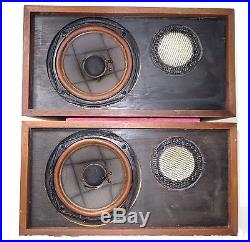
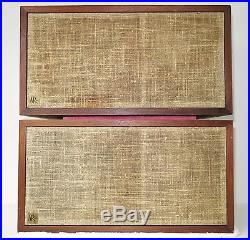

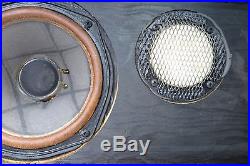
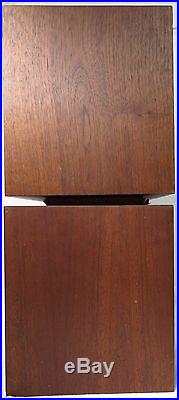

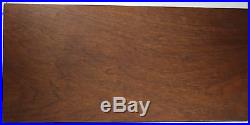
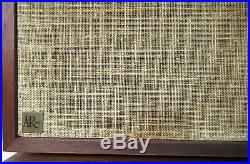


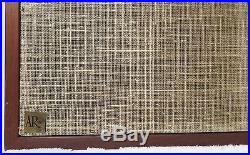
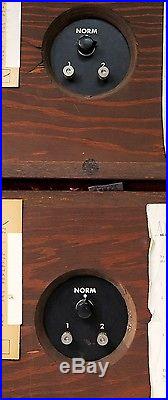
This is a one-owner pair of AR-4s, originally acquired directly from Acoustic Research in 1964 for a friend by AR president Edgar Villchur. These speakers were used only by the original owner when brand new, but were not used after around 1970. The serial numbers for these speakers are close together and relatively low in the series; one speaker was apparently mounted on the wall (there are two very small screw holes on the back that don’t penetrate the cabinet), but the other speaker must have been shelf-mounted. The grills are intact but one grill is dirtier than the other, but the grill can be cleaned with some care. The AR-4 grill was slightly different from the later beige grills used by AR, but it is still very handsome. The grills are stapled on the wood frame, and they can be removed with great care, and they can be cleaned, although it may not be necessary. No USM hot glue was used to mount these grills as they were stapled with small white staples all the way around. This makes grill cleaning and restoration much easier, but frankly the grill are fine the way they are and show the patina of 51 years. These speakers have worked well, but they have not been in regular use since the 1970. They have been stored on a shelf in very dry air-conditioned space since that time. They are 100% original, and the grill panels were removed for the first time to make images for this listing. Both woofers and both tweeters work well; the level controls are oxidized, but by turning the control back and forth extensively, the tweeters would begin to work fine on both speakers with the usual dropouts at certain points. The level controls should be removed and cleaned with a Dremel tool and then reassembled, but it is not mandatory that it be done. Tweeter output in both speakers is about on par with the early AR-4s, which is to say that treble response is very smooth and somewhat reticent, but this was normal. Treble output beyond around 15 kHz was beginning to drop off, but AR preferred smoothness and off-axis performance to bright on-axis output; therefore the acoustic-power response in the listening room is very smooth and extended. The LCR crossover network in both speakers appears to be fine, but it is well known that capacitors do begin to drift in value as they get older, and it might be appropriate to replace the crossover caps with newer version at a later point. The cabinets are generally in excellent shape with only minor marks and perhaps one small chip on an edge, easily fixed. Both AR logo plates are intact and completely original; the lacquer has given way somewhat and both logos are a bit dull because of tarnish and oxidation. This can be fixed, but the tarnish is not that bad. Acoustic Research AR-4 General Description. The AR-4 was introduced in October, 1964 and it included a new 3½-inch, treated-cone tweeter also used as the midrange driver in the 2. , in conjunction with a newly developed 8-inch acoustic-suspension woofer of outstanding performance and low distortion. This tweeter had excellent transient (tone-burst) response and smooth, undistorted and uniform frequency response, both on- and off-axis. The crossover was set at 1.5 kHz. The AR-4 was a brand-new compact design for Acoustic Research, a departure from the larger AR-1, AR-3 and AR-2 bookshelf designs, and it was built in relatively low numbers and for only one year until the introduction of the AR-4. The following year; thus the AR-4 is comparatively rare. Both the AR-4 and the more common AR-4. Were considered to be the finest small loudspeakers in the market for many years, and remained unsurpassed in smoothness of frequency response and low distortion for at least ten or fifteen years in this market segment. To this day, there are very few speakers this size that can matchlet alone surpassthe bass performance (low distortion) of the AR-4. It was a remarkable achievement in loudspeaker design. Julian Hirsch of Hirsch-Houck Labs, HiFi/Stereo Review , said of the AR-4, Unlike some smaller speaker systems that either go dead or distort badly below 70 Hz, the AR-4 produced very clean if diminished output down to at least 30 Hz. The smoothness of the system is attested to by the fact that no peaks or dips greater than 2.5 dB were measured from 30 to 15, 000 Hz. In short, the AR-4 was (and still is) one of the finest small loudspeakers ever produced for high-fidelity sound reproduction in the home. Noteworthy for its smooth and natural sound quality, this speaker has been a favorite for decades. The sheer quality of this little speaker also created a competitive spirit in the high-fidelity speaker industry for models in this price range that could compete with the tiny AR-4, and many competitive modelssuch as the KLH Seventeendid emerge that were generally on a par with this little speaker, but no small speaker built during this early period was truly comparable to the little AR-4 and AR-4. In terms overall sonic performance, accuracy, smoothness and natural sound reproduction. This was a fitting testimonial to this extraordinarily well-engineered little loudspeaker. Reproduction or copying of any of this material without the express permission of the writer is unlawful and strictly prohibited. These loudspeakers are 51 years old, and no guarantee as to long-term performance, safety or efficacy can be made for them. The item “Acoustic Research (AR) AR-4 Loudspeaker (pair) in Oiled Walnut, Vintage, VGC” is in sale since Wednesday, October 21, 2015. This item is in the category “Consumer Electronics\Vintage Electronics\Vintage Audio & Video\Vintage Speakers”. The seller is “acoustic-research-inc” and is located in High Point, North Carolina. This item can be shipped worldwide.
- Brand: Acoustic Research, Inc. “AR”
- Model: 1964 Model AR-4
- Country/Region of Manufacture: United States
